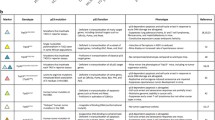Abstract
The loss or functional inactivation of tumor suppressor genes appears to be one of the most fundamental genetic mechanisms of tumorigenesis, and rational insights into the signaling pathways of tumor suppressor genes have emerged as a successful strategy of identifying novel drug discovery targets downstream of the tumor suppressor protein itself. Elucidation of novel pathways downstream of p53 have established a link between this important tumor suppressor gene and the insulin-like growth factor-1 receptor (IGF-1r), either via direct regulation of IGF-1 receptor levels, or modulation of IGFs via transactivation of the insulin-like growth factor-binding protein 3 (IGF-BP3) gene. Binding of IGF-BP3 to IGFs inhibits both their mitogenic and cell survival functions, highlighting a novel pathway whereby p53 may regulate apoptosis in tumor cells.
Similar content being viewed by others
References
Ko, L. J. and Prives, C. (1996).Genes Dev. 10, 1054–1072.
White, E. (1996),Genes Dev. 10, 1–15.
Cho, Y., Gorina, S., Jeffrey, P.D., and Pavletich, N.P. (1994).Science 265, 346–355.
Sabbatini, P., Lin, J., Levine, A.J., and White E. (1995).Genes Dev. 9, 2184–2192.
Caelles, C., Helmberg, A., and Karin, M. (1994).Nature 370, 220–223.
Haupt, Y., Rowan, S., Shaulian, E., Vousden, K.H., and Oren M. (1995).Genes Dev. 9, 2170–2183.
Rowan, S., Ludwig, R.L., Haupt, Y., Bates, S., Lu, X., Oren, M., and Vousden, K. H. (1996).EMBO J. 15, 827–838.
Murphy, M., Hinman, A., and Levine, A.J. (1996).Genes. Dev. 10, 2971–2980.
Werner, H., Karnieli, E., Rauscher, F.J. III, and LeRoith, D., (1996).Proc. Natl. Acad. Sci. USA 93, 8318–8323.
Prisco, M., Hongo, A., Rizzo, M. G., Sacchi, A., and Baserga, R. (1997).Mol. Cell. Biol. 17, 1084–1092.
Buckbinder, L., Talbott, R., Seizinger, B.R., and Kley, N. (1994).Proc. Natl. Acad. Sci. USA 91, 10,640–10,644.
Buckbinder, L., Talbott, R., Velsaco-Miguel, S., Takenaka, I., Faha, B., Seizinger, B. R., and Kley, N. (1995).Nature 377, 646–649.
Wang, Y., and Prives, C. (1995).Nature 376, 88–91.
Chen, X., Ko, L.J., Jayaraman, L., and Prives C. (1996).Genes Dev. 10, 2438–2451.
Ludwig, R.L., Bates, S., and Vousden, K. H. (1996)Mol. Cell Biol. 16, 4952–4960.
Baserga, R. (1994),Cell 79, 927–930.
Sell, C., Baserga, R., and Rubin R. (1995).Cancer Res. 55, 303–306.
Harrington, E. A., Bennett, M. R., Fanidi, A., and Evan G. I. (1994).EMBO J. 13, 3286–3295.
Hermeking, H., and Eick, D. (1994).Science 265, 2091–2093.
Ohlsson, G. Kley, N., and LeRoith, D. Unpublished result.
Jung, Y-K., Miura, M., and Yuan, J. (1996).J. Biol. Chem. 271, 5112–5117.
Neuberg, M., Lowe, S., and Kley, N. Unpublished result.
Author information
Authors and Affiliations
Corresponding author
Rights and permissions
About this article
Cite this article
Neuberg, M., Buckbinder, L., Seizinger, B. et al. The p53/IGF-1 receptor axis in the regulation of programmed cell death. Endocr 7, 107–109 (1997). https://doi.org/10.1007/BF02778075
Received:
Accepted:
Issue Date:
DOI: https://doi.org/10.1007/BF02778075




